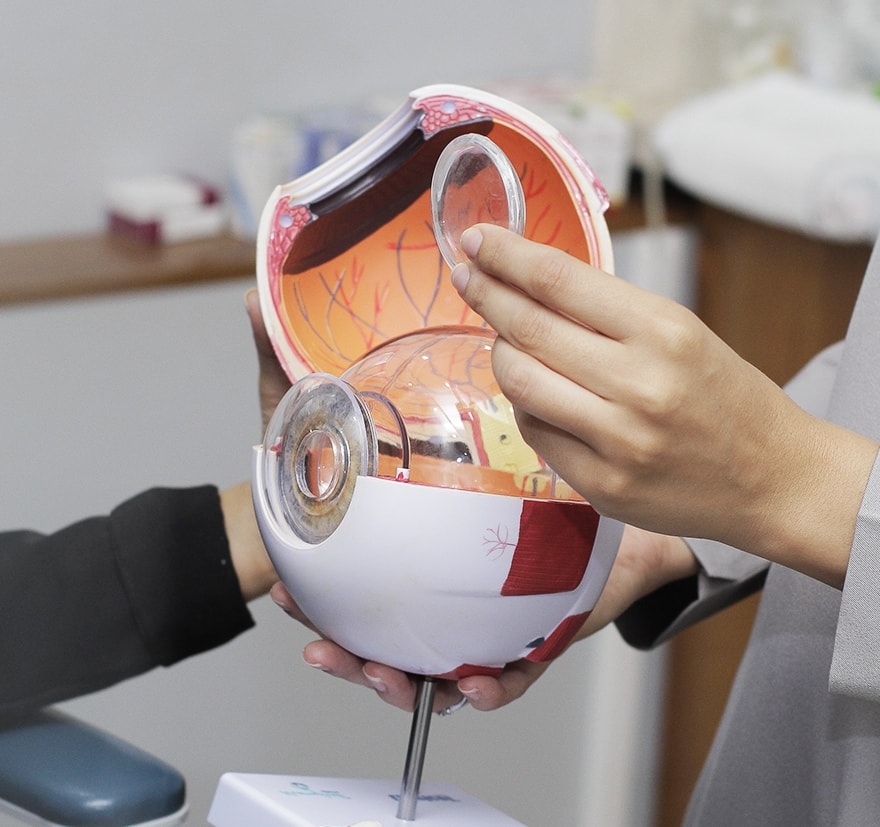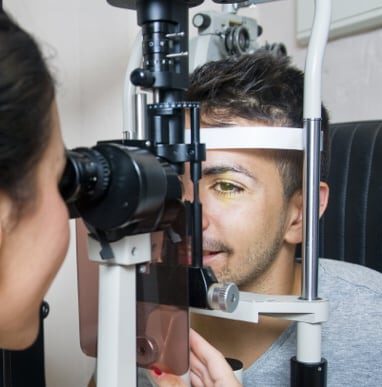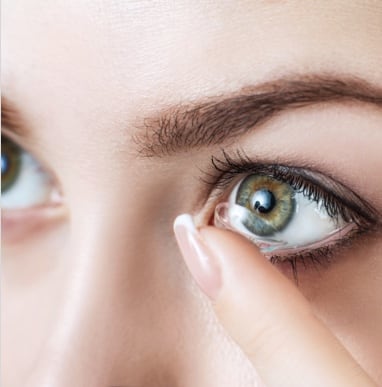
Early Detection Can Help Preserve Sight
People with diabetes have a 25% higher risk of developing sight-threatening conditions. Yet, annual eye exams can help prevent 95% of vision loss caused by diabetes.
Annual diabetic eye exams help you receive the care you need to preserve your sight.

How Diabetes & Your Eyes are Related
Diabetes is a chronic condition affecting how the body uses blood sugar. Uncontrolled blood sugar levels can damage blood vessels in the eye.
Blood vessels may develop irregularly, blocking blood flow and depriving eye tissue of nutrients. Weakened blood vessels can also leak into the eye, causing swelling or increased eye pressure.
Early detection and treatment can help lower the risk of blindness.

What Is Diabetic Eye Disease?
People with diabetes can develop diabetic eye disease, a group of conditions causing vision impairment.
- Cataracts are cloudy spots developing on the lens, causing blurry or obscured vision.
- Diabetic retinopathy decreases vision as blood vessels are damaged or grow abnormally, affecting retina function.
- Diabetic macular edema occurs when damaged blood vessels leak, causing the macula to swell and impair vision.
- Glaucoma damages the optic nerve, resulting in progressive vision loss as leaking blood vessels increase pressure inside the eye.

Monitoring Eye Health with Technology
People with diabetes can experience visual symptoms, but many changes are caused by problems affecting the back of the eye. Diagnostic technology helps us see details of tissue inside your eyes, so we can monitor how diabetes changes eye tissue and diagnose conditions when they develop.
iCare
The iCare tonometer is a handheld device used to evaluate eye pressure. A small, flat-tipped probe briefly touches the cornea (front of the eye). Then, eye pressure is calculated based on the force needed to flatten the cornea. Higher pressure can indicate glaucoma.
Optos Fundus Photography
Fundus photography uses a microscope to capture images of the back of the eye (the fundus). Optos retinal imaging can photograph a 200-degree view of the eye’s interior, providing details of the retina, optic nerve, and blood vessels.
Optical Coherence Tomography
Optical coherence tomography (OCT) is a noninvasive imaging test. The technology uses light waves to capture layered details of the retina (the light-sensitive tissue at the back of the eye).

Check in on Your Eye Health
Diabetes is the leading cause of vision loss in adults. People with diabetes may experience no symptoms until after damage has occurred. Therefore, it’s crucial to monitor visual health to detect changes as soon as possible.
Book your annual diabetic eye exam at Vision Care Center so we can help you care for your sight.

Our Locations
Peoria
Find us just south of the Sheridan & Glen intersection, across the street from Walgreens, on the same side of the road of Peoria Notre Dame High School.
To contact our Vision Therapy department, please call 309.670.2020 ext. 2, then choose Option #2 to be directed to VT.
- 309-670-2020
- 309-693-2536
- 309-670-2020
- 4727 N Sheridan Road
- Peoria, IL 61614
Our Hours
- Monday: 8:00 AM – 5:00 PM
- Tuesday: 8:00 AM – 5:00 PM
- Wednesday: 9:00 AM – 5:00 PM
- Thursday: 8:00 AM – 5:00 PM
- Friday: 8:00 AM – 5:00 PM
- Saturday: 8:00 AM – 12:00 PM
- Sunday: Closed
Washington
You can find our office on North Cummings Lane, right next door to Rock Valley Physical Therapy. We offer plenty of parking in front of our clinic with accessible parking stalls.
To contact our Vision Therapy department, please call 309.670.2020 ext. 2, then choose Option #2 to be directed to VT.
- 309-444-8811
- 309-444-7863
- 309-444-8811
- 1009 North Cummings Lane
- Washington, IL 61571
Our Hours
- Monday: 9:00 AM – 5:00 PM
- Tuesday: 9:00 AM – 5:00 PM
- Wednesday: 9:00 AM – 5:00 PM
- Thursday: 9:00 AM – 5:00 PM
- Friday: 8:30 AM – 12:00 PM
- Saturday: Closed
- Sunday: Closed
Our Google Reviews










